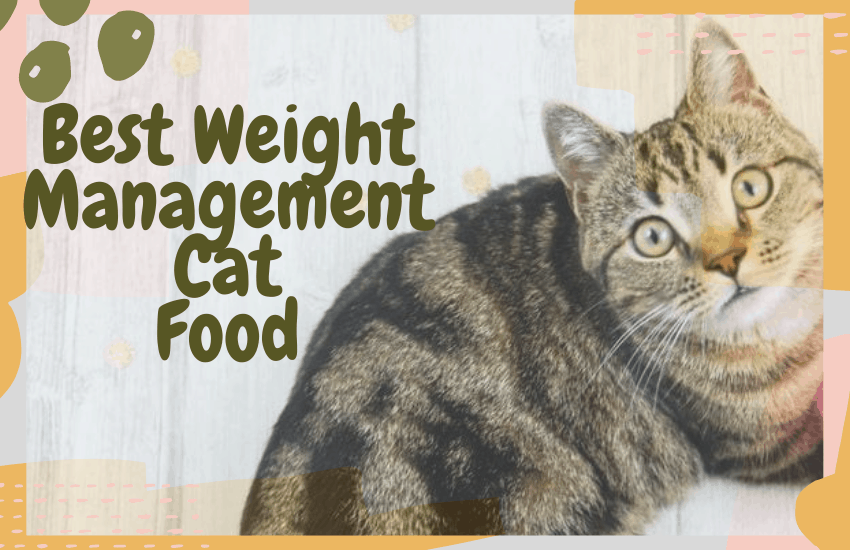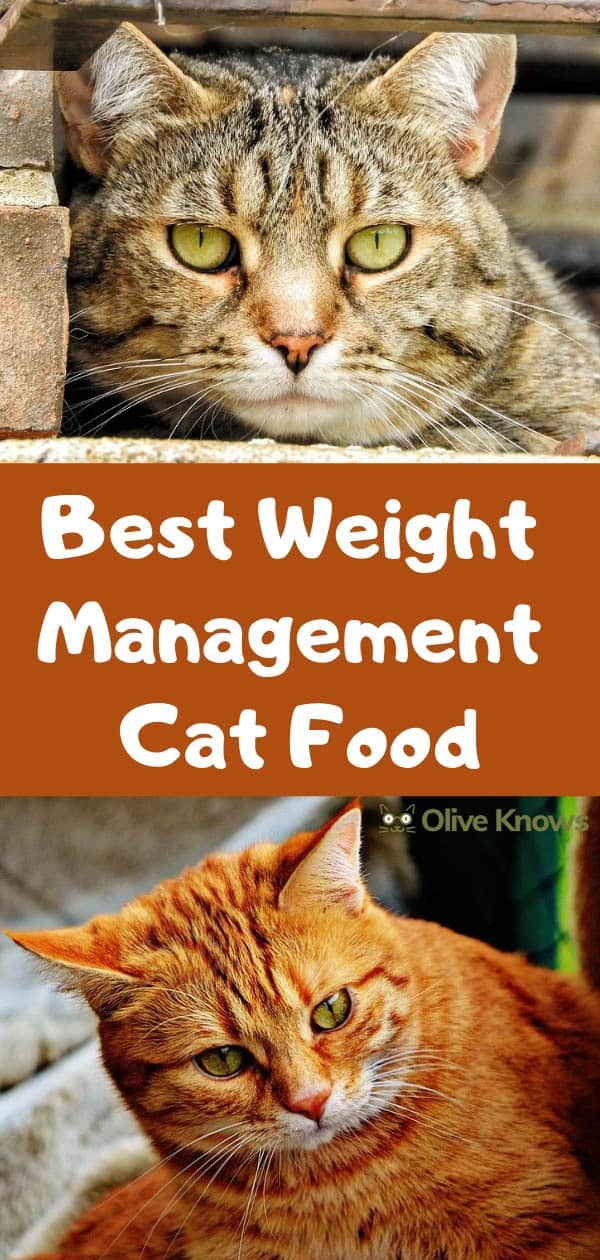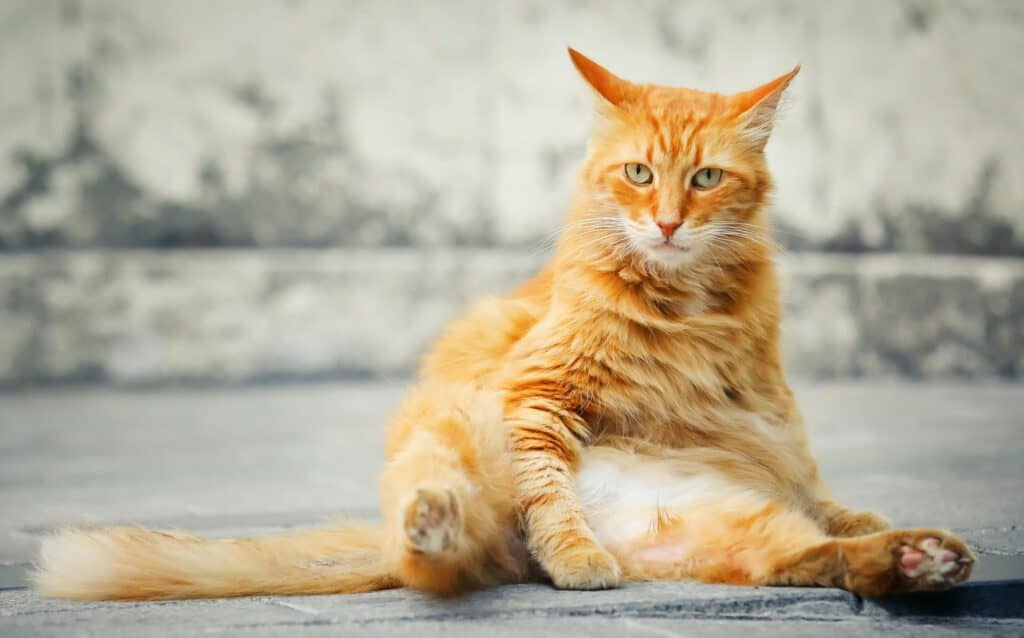
“Aw, look at this cute furball.” This is a common reaction when cat-lovers see a chubby cat. Yet, it is also the wrong statement. Blinded by the image of the “furball” snuggling on our lap, we often forget that cats are living creatures. Keeping their weight at an optimal level is detrimental to their health and quality of life. Here are some tips on how to keep your cat lean, what to do if her weight has gone overboard and which foods for overweight cats we recommend.

Table of Contents
Cat Weight
Naturally, keeping your cat’s weight under check at all times is always better than having to take measures after she has gained an extra pound. Make no mistake, a pound might not sound a lot, but when you do some simple math, you’ll see that a 10lb cat gaining a pound is like a 180lb person gaining 18lbs. In any case, if your cat is gaining weight or you are noticing that her body shape is changing, only a vet can determine the cause and prescribe a course of action.
Ideal
So, what’s the ideal weight for cats? 10-12 lbs are considered to be a healthy range, but the exact number will vary. There are some breeds with larger body frames which will naturally weigh more. Also, note that being “obese” or “overweight” is not so much about weight as it is about fat percentage. Muscle is denser than fat, meaning more weight fits in a smaller area. So, if your cat has developed strong muscles due to being active, it might pack a few extra pounds without being considered overweight.
Overweight/Obese
Unfortunately, very few cats gain weight due to muscle gain. The statistics show that 50% of domestic cats in the US are either overweight or obese (their weight is at least 20% over what’s normal).
Several factors play detrimental roles here. The most prominent one is the convenience of manufactured cat food. Not only is most of it too calorie-dense and full of carbs, but the majority of owners tend to free-feed their cats. Add to that the lack of activity among most domesticated cats and you’ve got a recipe for disaster. Not only are cats eating fattening food, but they get it 24/7 and don’t even have to hunt for it. Of course, weight gain can also happen due to medical issues as we will discuss next.
Dangers of Cat Obesity
There two major dangers relating to cat obesity – first, obesity can be caused by an illness and, second, obesity can cause illnesses.

Illnesses Causing Obesity
Malfunctions in the thyroid gland are getting more common across people from all over the globe, but cats can also develop them. Hypothyroidism– a chronic drop in the activity of the thyroid gland– can cause weight gain in both people and cats. Don’t try to self-diagnose it though; Thyroid conditions are serious and need to be confirmed and treated by a medical professional.
Obesity-caused Illnesses
Apart from being caused by an illness, obesity can lead to such. Most of them not only seriously affect your cat’s quality of life, but considerably shorten her life expectancy. As you’ll see below weight gain is no laughing matter.
Diabetes
Yes, cats do get diabetes. As you know this is a vicious disease which in most cases haunts its victims throughout their lives. Usually, diabetes is a lifestyle-related disease, meaning that the way you take care of your cat, especially in terms of diet, is vital to keeping her off insulin shots for the rest of her life.
Cardiovascular Issues
Excessive fat gets stored all over the body and can engulf the heart, causing it to work inefficiently. Also, fat gets caught in blood vessels, constricting the passage of blood which in turn causes a myriad of life-threatening complications.
Arthritis
Arthritis is a joint condition which makes every movement painful. If your cat’s skeletal system struggles to hold all the extra weight, bones and joints give in causing your pal to suffer. Without proper care, a cat who’s in pain while moving will be even less active and gain even more weight.
Cancer
No surprise here. Having extra pounds compromises the immune system which is the principal defense against cancer. On top of that, feeding your cat low-quality food means that she ingests on a daily basis cancerogenic ingredients like artificial colorings and flavorings.
Best Cat Food for Weight Management
When looking for quality food for weight management, there are several things to consider – calories, carbs, and quality of the ingredients. Here are our suggestions:
Orijen Fit & Trim
When shopping for cat food, you can’t go wrong with Orijen. It’s a premium brand at a premium cost, but the quality is unmatched by any other widely available manufacturer.
Like any other formula by Orijen, the Fit & Trim one consists of primarily high-quality proteins. This trimming formula also doesn’t load up your cat on carbs and contains an appropriate amount of fats. Also, the manufacturer promises that 2/3 of its meats are fresh or raw, meaning no preservatives. The people behind Orijen also don’t shy away from providing a complete breakdown of the ratio of different protein sources.
If Orijen is a bit too much for your pocket, we do have an alternative.
Halo® Holistic Healthy Weight Grain-Free Chicken and Chicken Liver Recipe for Indoor Cats
This formula by Halo was developed specifically for indoor cats. It contains chicken and chicken liver as the first two ingredients and dried egg as the third one. The manufacturer promises no GMO ingredients in the formula and no artificial preservatives, colors or flavors. Unfortunately, the formula does contain some grains like chickpeas and soy protein, but we couldn’t find a weight-management formula that didn’t compromise on the ingredients list.
The other formulas that we reviewed, however, compromised quite a bit with lots of added grains, carbs, and even artificial ingredients, so they don’t have any place here.
Other Ways to Keep Your Cat’s Weight in Check
Apart from choosing the appropriate food, there are other things that you should do to keep your cat’s weight in a healthy range. But whatever you do, be mindful of doing it gradually. Any sudden change in your cat’s feeding or exercise habits will most likely backfire.
Portion Control
It’s quite easy to fill your cat’s bowl and leave her to indulge on as much as she wants. However, one of the key moments in keeping your cat’s weight under check is to make sure that she only eats as many calories as she exhausts. So, when considering the daily portion size, consider her activity and do not rely on the cat food label. Manufacturers provide very general guidelines based on what they consider to be an “average” cat.
Scheduled Feeding
Free-feeding your cat is the most convenient way to do it. But letting your cat eat whenever she wants is as bad as leaving copious amounts of food. The problem is that many cat owners cannot feed their cat on a schedule due to their daily lives. We know that you probably go to work or do some other stuff that prevents you from feeding your cat at predetermined hours. Fortunately, there are many automatic feeders with timers which will release the right amount of food at the right time. To make it easy for you we’ve compiled some of the best options.
Exercise
Calories in – calories out. To keep your cat at a healthy weight, you need to provide her with entertainment. In the wild, cats would hunt all day so they’ll spend quite a few calories. Alas, this is not the case with the convenient bowl of food that’s available all day long. One of the best options that you can take is to combine feeding with play. To do this, you can keep some of your cat’s daily portion in a treat ball like this one from Playay or a slow feeder like this one.
Cat Food Only
Cat owners often don’t think about the food that their cat is getting in addition to her daily portion. A piece of bacon here, a spoon of tuna there and the calories quickly add up. Plus, cat treats, harmless as they might look, can be very calorie dense without being nutritious. So, ease on the “additional” meals and make sure that you don’t feed your cat any human food that might be dangerous to her anyway.
Dietitian/Vet
Cats are quite sensitive to diet change so you shouldn’t attempt any diets before you’ve consulted with a specialist. Hepatic lipidosis is a serious liver condition which cats can develop within days if their diet is drastically changed or they suddenly get less food than usual.
Keep her Healthy
Cats are notorious for their stoicism so you might not notice developing issues on time. Doing regular checks at the vet will save you lots of trouble down the road. Plus, it’ll let your cat enjoy a long and happy life which is in your hands.
If your cat is getting on the fat side or is already obese, hopefully, this post will point you in the right direction in helping her. As cute as fat cats might look, they indeed need help which they cannot get by themselves. By getting a cat, you’ve taken responsibility for its wellbeing, and you need to act on it. If you notice that your furry pal is having trouble get him to vet and sort it out.




Leave a Reply